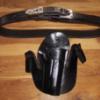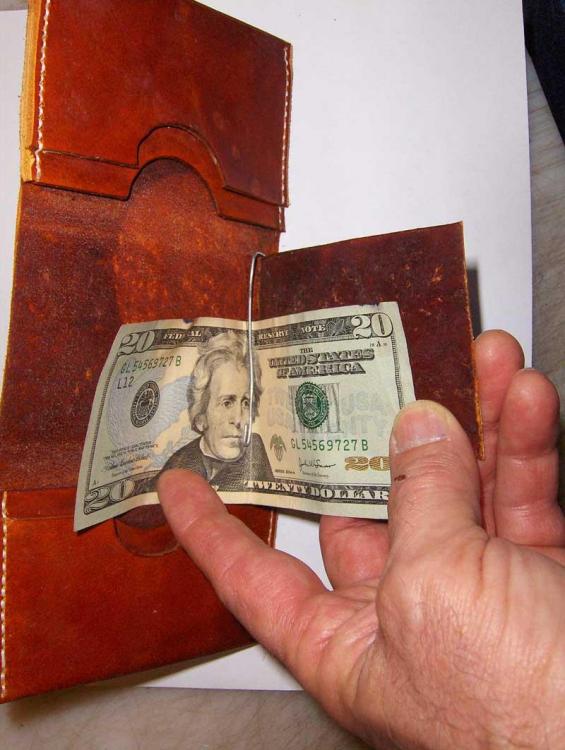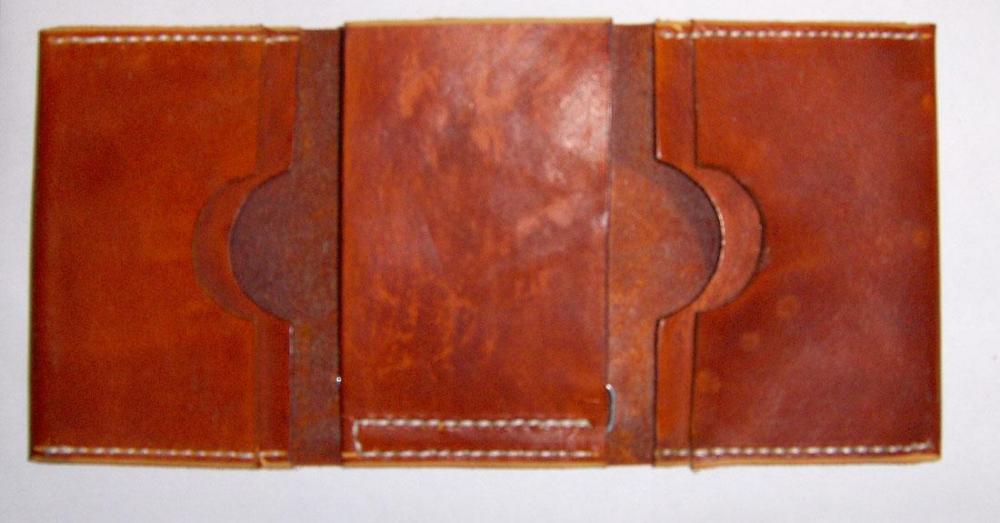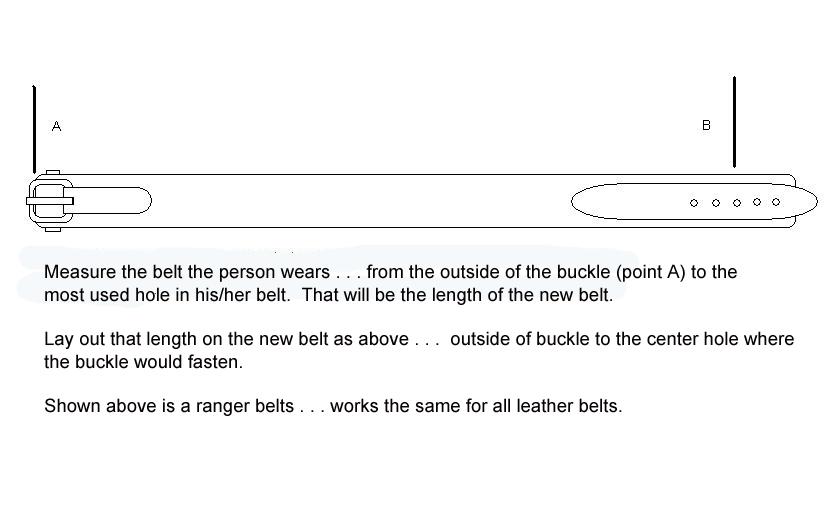-
Posts
5,228 -
Joined
-
Last visited
Content Type
Profiles
Forums
Events
Blogs
Gallery
Everything posted by Dwight
-
I have never noticed it making any difference as far as the shape is concerned . . . but the holster will definitely be a bit more firm coming out of a hot box. My hot box is very similar to Lobo's . . . but I have 3 bulbs in the bottom . . . May God bless, Dwight
-
The Bible book store I got my last one from . . . used a machine such as you describe. They simply loaded in the name . . . warmed it up . . . pressed it onto the Bible . . . and the name was there. Still there some 35 years later. May God bless, Dwight
-

Tom Threeperson Holster
Dwight replied to Wykoni's topic in Gun Holsters, Rifle Slings and Knife Sheathes
Not sure how the OP did it . . . I do mine so that it is in a place where the gun does not touch the leather . . . and it can be tricky. May God bless, Dwight -
Several years back . . . in a Tandy shop . . . a fellow came in wanting someone to make him a wallet. The manager sent him over to me as I just happened to be there. The story was his daughter had bought him a wallet some 25 years before . . . it was now worn out . . . he needed as near as possible an exact replacement. I looked at it . . . saw it was very simple . . . we agreed on the terms . . . he unloaded the wallet and gave it to me for a pattern . . . and away we went . . . the finished product was sent to him a couple weeks later . . . and I got a very pleasant thank you note from him. This is the "practice piece" I did just to get the feel of it. It is a trifold . . . couple of pockets on each side . . . with a bill holder in the middle. May God bless, Dwight
-
Much better there Cyberwolfe . . . May God bless, Dwight
-

In The Process For A Wheelchair Mount
Dwight replied to AzShooter's topic in Gun Holsters, Rifle Slings and Knife Sheathes
Looks good partner . . . is that 1/2 inch or 3/4 inch wooden dowel you used??? And how long is it?? May God bless, Dwight -

In The Process For A Wheelchair Mount
Dwight replied to AzShooter's topic in Gun Holsters, Rifle Slings and Knife Sheathes
Looking fwd to the picture. May God bless, Dwight -
I really cannot comment on the Outlaw . . . but I've had a Tipmann Boss for over 15 years . . . and it has pretty much done all I ever wanted it to do. I can also make another comment . . . which pertains easier to me because of location . . . when I've had a problem with it (twice) . . . I laid it in the passenger seat . . . and two hours later, I'm standing behind Ben . . . he is fixing the problem . . . and I'm back on my way. Your location will not work for that . . . but they are solid on fixing any problems that arise. The worst problem I've ever had with it . . . it does not like to go around circular corners . . . never figured out why . . . it just doesn't . . . and sometimes the back side of the stitching is a bit less than optimal. It's great for holsters . . . dog collars . . . knife sheaths . . . but belts can be a pain if you have a shoulder problem. Put it to prayer . . . let the Lord help you with the decision . . . that actually is my best piece of advice. People ask me if the Lord is my steering wheel or my life preserver . . . I claim He is my GPS . . . gives me the directions before I get there. May God bless, Dwight
-
On a question of "How To" . . . How do we get rid of the pictures of the junk yard up at the top of the screen . . . and get some useful and decorative leather work pictures in their place?? If this were Sanford and Son . . . I could understand it . . . but this is a leatherwork forum . . . not a showcase for derelict mechanical junk. May God bless, Dwight
-
Mom taught me that trick 65 years ago. It still works too. May God bless, Dwight
-

How do I avoid cracks when bending leather - Example of Small Bag
Dwight replied to GinBerlin's topic in How Do I Do That?
Those are not cracks . . . they are wrinkles . . . they are produced by the bending of the leather. Getting it fairly wet with water that first time you bend it will alleviate some of it . . . but also using a thinner leather will also make a big difference. The thinner leather will not wrinkle as bad. You may skive the area that bends . . . do that on some practice pieces . . . it may be your ticket. Also you can bend it around a dowel . . . slowly and incrementally making the dowel smaller each time . . . pulling it around by the loose end . . . rather than just bending it over the piece. BUT . . . wrinkles are part and parcel to leather and leather work. It proves your work was not done in wool, cotton, or plastic . . . May God bless, Dwight -
Instead of carving it . . . do a control C of the pic . . . paste it into a MS Word page . . . and print the page. Use waxed paper and a ink jet printer . . . and if I remember the process correctly . . . you then just transfer the wet ink to the leather . . . rub it with a rag . . . till you see there is no more ink left on the wax paper . . . you are done. NOW . . . I'm going from memory . . . did it 10 or so years ago . . . check out the internet for better directions. You WILL GET a really nice image if you take your time. I did my son's face on a piece of leather . . . was really good. OR . . . if you don't want to do that . . . print it on white paper . . . use school latex glue to glue the paper to the leather . . . then use a wood burning tool to trace and add the lines to the leather by lightly burning it. Make sure the burner is turned low . . . and take your time. It also produces a beautiful image if you are patient as you do it. May God bless, Dwight
-

A tight and durable seam on an 8oz veg tan quiver?
Dwight replied to SeyR's topic in How Do I Do That?
A. Make sure your two edges are exactly 90 degree cuts . . . and as near perfectly straight as you can make them. B. Contact cement the edges together C. I would (for a simple quiver) use a much simpler stitch pattern than Garypl used .. . . just a simple XXXXXXXXX stitch straight down the seam. D. To help insure it stays together . . . I'd put my shoulder strap attachments at the top and bottom of the seam . . . with a 3/4 inch or so wide strip running down the outside . . . with the ends of it becoming the anchor points for said shoulder strap. For garden variety pratice arrows . . . nothing needed . . . but for my broadhead arrows . . . each one goes into a separate plastic tube liner. May God bless, Dwight -
Chris . . . the easy way to do this . . . forget about the 7/8 oz leather you would have used. Get some really good 3/4 that is closer to the 4 side. You make two sheath blanks . . . mirror cut from each other. The piece with the hair side out . . . inlay your snake . . . sew him in place . . . . then contact cement both together and from that "one piece" continue making your sheath just as you usually would. I regularly make 6 shooter holsters this way . . . and when done. . .the nice thing is they are really sturdy. AND . . . you don't have to skive anything here . . . May God bless, Dwight
-
Rivets are usually put in cheap stuff . . . so it won't come apart. They don't put in a welt . . . so the knife cuts the stitches . . . voila . . . it comes apart. SOooooo they put a rivet in there to keep it together . . . and your knife drags across the rivet . . . dulling it faster than skinning two democrats. Nahhhh . . . no rivets . . . put in a good welt to protect the blade . . . that is the American way. May God bless, Dwight
-

Rhino 60DS Holster
Dwight replied to thawk8541's topic in Gun Holsters, Rifle Slings and Knife Sheathes
Looks good from here. Revolvers . . . especially in western rigs are really OK with home grown models . . . semi-autos in CCW rigs are a different story . . . but it CAN BE done. Hang onto that model . . . word gets out . . . you may be Mr. Chiappa . . . May God bless, Dwight -
I use a concoction of 50 % by weight . . . pure bees wax and 50% by weight . . . neats foot oil. Not the compound . . . the real OIL. I put it in a jar . . . suspend the jar in a pan of hot water . . . it melts the beeswax . . . they get melded together . . . Rub it on the leather . . . polish . . . you'll like it. It's a 100+ yr old recipe . . . add more oil if you want it a bit softer. I've made and use both. May God bless, Dwight
-

Lining for CAS gun belt?
Dwight replied to Jaan's topic in Gun Holsters, Rifle Slings and Knife Sheathes
I only make and use . . . two pieces of 7/8 veg tan . . . cemented together so hair side is out on both sides . . . and sewed . . . Or a folded 7/8 piece sewn at the top . . . it becomes a money belt. Don't do anything else. May God bless, Dwight -

New Tote bag for my daughter.
Dwight replied to Mattsbagger's topic in Purses, Wallets, Belts and Miscellaneous Pocket Items
Let double down on hating to put work into something that won't be appreciated. I built a very pretty bag for a young lady once as a wedding present. Spent many hours on it . . . getting it right . . . picking the colors, the leather, the accouterments, etc. Several months after the wedding . . . I got a strange email from someone I'd never met . . . asking me about the bag. She had picked it up in a flea market. Yeah . . . it still aggravates me. If someone had done that for me . . . if nothing else . . . I'd a put it away in the attic . . . just so I could honestly tell them I still have it . . . May God bless, Dwight -

Belt length measurements and centering names on the back
Dwight replied to Maint1517's topic in How Do I Do That?
This is an easy one . . . take a look at the drawing . . . it pretty much explains it all. The only difference I make . . . instead of 5 holes for adjustment . . . I give them 7 holes . . . gives room to lose more weight . . . or have another slice or two of pizza. Oh . . . and the distance from point B to the end of the belt is 9 inches for my belts. Some make it a bit longer . . . some cut it down. I think it makes a better looking belt that way . . . May God bless, Dwight -
In truth . . . we do live in a very small world . . . Europeans have lots of relatives here . . . we have lots of relatives there . . . most of which do not know one another . . . I read one time that if you knew all of the friends of all your friends . . . to go out 26 generations of friends knowing friends . . . you would know everyone in the world. Sobering thought . . . But like you . . . I think it would do a lot of good if we all could see better the roots that make us who we are . . . physically, mentally, and emotionally. Racism and bigotry would take a serious nose dive if a lot of people actually knew ALL of their ancestry. The perfect example is one of the most racist bigots ever . . . Oprah . . . who claims she is super glad that two DNA tests proved there is no white people in her ancestry . . . but I've got news for her . . . she did not get that lighter skin tone by not going out in the sun. There's a white boy or two back there somewhere in her makeup . . . May God bless, Dwight
-
I have successfully cut wet leather . . . just make sure the edge will somehow not make any super difference. That would be if that edge were sewn over another . . . or braided . . . or sanded . . . But the best idea is to make a template . . . get your size and dimensions that way . . . it's good and good for you. May God bless, Dwight
-
Me too even . . . on the DNA from Ancestry.com . . . my wife's was basically England with a tad from Irelend tossed into the mix. Mine hit the Heinz 57 . . . but the funny part was I was always told German, Dutch, English, Irish, and Native American. Ancestry nixed the German and Dutch . . . added East Med (Israeli or close by) . . . French . . . Scottish . . . Nordic and way over in Eastern Europe . . . I'm planning on getting some good stories once i'm walking the streets of gold . . . find them all and get the fact line on what went down . . . But thanks again . . . on the book . . . Ebay had a paperback for 6 bucks delivered . . . it'll be one of my "lavatory library" tomes . . . May God bless, Dwight
-
Not sure which one . . . but if my cousin was here . . . she could probably look in one of her books and tell ua how Walter Prescott Webb is related to us. . . . and which cousin he is . . . lol. One of the great things in my "Webb" family is the two threads that seem to run rampant thru the family . . . wanting to know how something WAS done . . . or wanting to know how to DO something for the first time. This one was a past tense chaser. But, thanks . . . I'll have to check that book out . . . I'll probably like it even if it didn't have the Webb moniker on it. May God bless, Dwight
-
What works for one . . . may not for another . . . but if you mess with it long enough though . . . you will find the one that works for you. I mark one end of mine . . . the spot on the "other side" away from me . . . and put the heel of the punch over there. I give it a couple light taps . . . watching it go down into the leather . . . and using the aforementioned eye/hand coordination I slowly start working the punch down into the leather as I work the cutting part towards me. If there is any doubt as to how straight or crooked it is . . . lift the punch and check it out. You can move the punch a bit and get away with it most of the time. Slow medium punches work best for me . . . a firm tapping motion. BUT . . . another key to making sure it works . . . the surface under the leather cannot be a bouncy surface. On those punches . . . I am directly over a leg of my work table . . . and it goes a lot, lot, lot smoother. ALSO . . . if you have any beeswax . . . rub your punch all the way around on the beeswax . . . it makes things go so much easier. May God bless, Dwight





